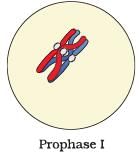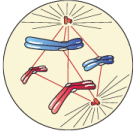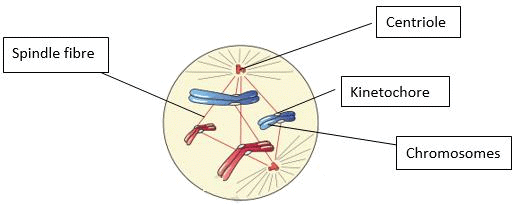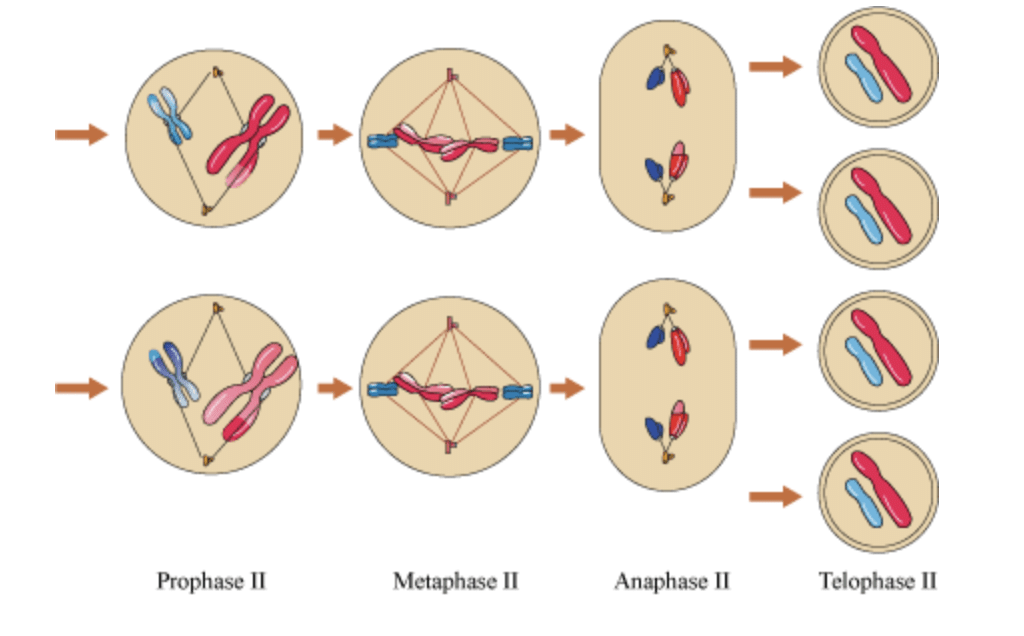NCERT Exemplar: Cell Cycle & Cell Division | Biology Class 11 - NEET PDF Download
| Table of contents |

|
| Multiple Choice Questions |

|
| Very Short Answer Type Questions |

|
| Short Answer Type Questions |

|
| Long Answer Type Questions |

|
Multiple Choice Questions
Q1. Meiosis results in diploid organisms
(a) Production of gametes
(b) Reduction in the number of chromosomes
(c) Introduction of variation
(d) All of the above
Ans: (d)
Meiosis reduces chromosome number, produces gametes, and introduces genetic variation.
Q2. At which stage of meiosis does the genetic constitution of gametes is finally decided
(a) Metaphase I
(b) Anaphase II
(c) Metaphase II
(d) Anaphase I
Ans: (b)
- During Anaphase II, the sister chromatids separate.
- This separation is crucial as it determines the genetic constitution of the gametes.
- Each gamete will receive a unique combination of genes, leading to genetic diversity.
Q3. Meiosis occurs in organisms during
(a) Sexual reproduction
(b) Vegetative reproduction
(c) Both sexual and vegetative reproduction
(d) None of the above
Ans: (a)
Meiosis occurs during sexual reproduction, where it plays a crucial role in the formation of gametes. Key points include:
- Meiosis reduces the chromosome number by half.
- It ensures genetic diversity in offspring.
- Four haploid daughter cells are produced at the end of meiosis.
Q4. During anaphase-I of meiosis
(a) Homologous chromosomes separate
(b) Non-homologous chromosomes separate
(c) Sister chromatids separate
(d) Non-sister chromatids separate
Ans: (a)
During Anaphase I of meiosis:
- Homologous chromosomes separate.
- Sister chromatids remain attached at their centromeres. This separation is crucial for reducing the chromosome number in gametes.
Q5. Mitosis is characterised by
(a) Reduction division
(b) Equal division
(c) Both reduction and equal division
(d) Paining of homologous chromosomes
Ans: (b)
Mitosis
- Mitosis is known as an equal division process.
- It maintains the same chromosome number in the daughter cells as in the parent cell.
- The stages of mitosis include:
- Prophase: Chromosomes condense and become visible.
- Metaphase: Chromosomes align at the cell's equator.
- Anaphase: Sister chromatids separate and move to opposite poles.
- Telophase: Nuclear membranes reform around the separated chromosomes.
- After mitosis, cytokinesis occurs, dividing the cytoplasm and forming two daughter cells.
Q6. A bivalent of meiosis-I consists of
(a) Two chromatids and one centromere
(b) Two chromatids and two centromere
(c) Four chromatids and two centromere
(d) Four chromatids and four centromere
Ans: (c)
A bivalent in meiosis I comprises:
This structure is formed when homologous chromosomes pair up during the process of meiosis.
- Four chromatids
- Two centromeres
Q7. Cells which are not dividing are likely to be at
(a) G1
(b) G2
(c) Go
(d) S phase"
Ans: (c)
- Cells in the G0 phase are in a non-dividing state.
- This phase is also known as the quiescent phase.
- During G0, cells remain metabolically active but do not proliferate.
- Cells may re-enter the cell cycle when needed, depending on the organism's requirements.
Q8. Which of the events listed below is not observed during mitosis?
(a) Chromatin condensation
(b) Movement of centrioles to opposite poles
(c) Appearance of chromosomes with two chromatids joined together at the centromere.
(d) Crossing over
Ans: (d)
The event that is not observed during mitosis is:
- (d) Crossing over
Crossing over occurs during meiosis, not mitosis. It involves the exchange of genetic material between homologous chromosomes, which does not happen in mitosis.
Q9. Identify the wrong statement about meiosis.
(a) Pairing of homologous chromosomes
(b) Four haploid cells are formed
(c) At the end of meiosis the number of chromosomes is reduced to half
(d) Two cycles of DNA replication occur.
Ans: (d)
Meiosis involves two sequential cycles of nuclear and cell division called meiosis-I and meiosis-II but only a single cycle of DNA replication.
Q10. Select the correct statement about G1 phase
(a) Cell is metabolically inactive
(b) DNA in the cell does not replicate
(c) It is not a phase of synthesis of macromolecules
(d) Cell stops growing
Ans: (b)
- During the G1 phase, the cell is metabolically active and grows.
- DNA replication occurs in the S phase, not in G1.
- Thus, the correct statement is:
- B) DNA in the cell does not replicate.
Very Short Answer Type Questions
Q1. Between a prokaryote and a eukaryote, which cell has a shorter cell division time?
Ans: Prokaryotic cells divide faster than eukaryotic cells. Typically:
- A human eukaryotic cell divides approximately every 24 hours.
- In contrast, a bacterium like E. coli can complete its cell cycle in about 20 minutes.
Q2. Which of the phases of the cell cycle is of the longest duration?
Ans: Interphase is the longest phase of the cell cycle.
- In a typical 24-hour cell cycle:
- 23 hours are spent in interphase.
- Only 1 hour is allocated for the M phase (mitosis).
During interphase, the cell prepares for division by:
- Growing and duplicating its DNA.
- Completing essential metabolic processes.
Overall, interphase accounts for more than 95% of the cell cycle duration.
Q3. Name a stain commonly used to colour chromosomes.
Ans: Basic fuchsin and acetocarmine are commonly used stains to colour chromosomes.
Q4. Which tissue of animals and plants exhibits meiosis?
Ans: Meiosis occurs in specific tissues of both animals and plants:
- Animals: In the gonads (testes and ovaries).
- Plants: In the sporangium.
Q5. Given that the average duplication time of E.coli is 20 minutes, how much time will two E.coli cells take to become 32 cells?
Ans: To determine the time required for two E. coli cells to multiply into 32 cells, we need to consider the number of duplication cycles involved:

- Each division = 20 min
- Total time = 4 × 20 = 80 minutes
Q6. Which part of the human body should one use to demonstrate stages in mitosis?
Ans: Epithelial tissue (like cheek cells) or bone marrow cells are typically used in humans.
Q7. What attributes does a chromatid require to be classified as a chromosome?
Ans: A chromatid becomes a chromosome after separation during anaphase and gaining its own centromere.
Q8. The diagram shows a bivalent at prophase-I of meiosis. Which of the four chromatids can cross over? Ans: The homologous chromosomes lie parallel to each other in leptotene stage. Each chromosome has four chromatids and are bivalent. The non-sister chromatids of homologous chromosomes cross over in pachytene stage of prophase-I
Ans: The homologous chromosomes lie parallel to each other in leptotene stage. Each chromosome has four chromatids and are bivalent. The non-sister chromatids of homologous chromosomes cross over in pachytene stage of prophase-I
Q9. If a tissue has at a given time 1024 cells, how many cycles of mitosis had the original parental single cell undergone?
Ans.
1024 = 2n
n = No. of Cycles
1024 = 210 = 2n => n = 10
Therefore, the parent will undergo 10 rounds of mitosis.
Q10. An anther has 1200 pollen grains. How many pollen mother cells must have been there to produce them?
Ans: 4 pollen grains are produced by 1 pmc, 1200 pollen grains are produced by = 1200/4
= 300 pmc
Q11. At what stage of cell cycle does DNA synthesis take place?
Ans: S-phase (interphase)
Q12. It is said that the one cycle of cell division in human cells (eukaryotic cells) takes 24 hours. Which phase of the cycle, do you think occupies the maximum part of cell cycle?
Ans: It is significant to note that in the 24 hour average duration of cell cycle of a human cell, cell division proper lasts for only about an hour. The interphase lasts more than 95% of the duration of cell cycle.
Q13. It is observed that heart cells do not exhibit cell division. Such cells do not divide further and exit ___________ phase to enter an inactive stage called ___________ of cell cycle. Fill in the blanks.
Ans: It is observed that heart cells do not exhibit cell division. Such cells do not divide further and exit G1 phase to enter an inactive stage called G0 of cell cycle.
Q14. In which phase of meiosis are the following formed? Choose the answers from hint points given below.
(a) Synaptonemal complex ____________
(b) Recombination nodules ____________
(c) Appearance/activation of ___________ enzyme recombinase
(d) Termination of chiasmata __________
(e) Interkinesis ____________________
(f) Formation of dyad of cells __________
Hints : 1) Zygotene, 2) Pachytene, 3) Pachytene, 4) Diakinesis, 5) After Telophase-I /before Meiosis-II, 6) Telophase-I /After Meiosis-I.
Ans:
(a) Synaptonemal complex: zygotene
(b) Recombination nodules: pachytene
(c) Appearance/activation of pachytene enzyme recombinase
(d) Termination of chiasmata: diakinesis
(e) Interkinesis: after Telophase-I /before Meiosis-II
(f) Formation of dyad of cells: Telophase-I /after Meiosis-I.
Short Answer Type Questions
Q1. State the role of centrioles other than spindle formation.
Ans: The centrioles form the basal body of cilia or flagella.
Q2. Mitochondria and plastids have their own DNA (genetic material). What is known about their fate during nuclear division like mitosis?
Ans: At the time of cytoplasmic division, organelles like mitochondria and plastids get distributed between the two daughter cells.
Q3. Label the diagram and also determine the stage at which this structure is visible. Ans: This is a transition to metaphase.
Ans: This is a transition to metaphase.

Q4. A cell has 32 chromosomes. It undergoes mitotic division. What will be the chromosome number (N) during metaphase? What would be the DNA content (C) during anaphase?
Ans:
- Chromosome number remains 32 (2n)
- DNA content in anaphase: each chromosome splits, so each pole temporarily has 32 chromosomes = 2C each
- Total DNA content = 4C temporarily, then reduced to 2C per cell after telophase
Q5. While examining the mitotic stage in a tissue, one finds some cells with 16 chromosomes and some with 32 chromosomes. What possible reasons could you assign to this difference in chromosome number? Do you think cells with 16 chromosomes could have arisen from cells with 32 chromosomes or vice versa?
Ans: Cells with 16 chromosomes are produced by meiosis while those with 32 chromosomes are produced by mitosis.
Mitosis maintains chromosome number (32→32), while meiosis reduces (32→16)
Cells with 32 can arise from 16 after fertilisation (16 + 16 → zygote with 32)
Q6. The following events occur during the various phases of the cell cycle. Name the phase against each of the events.
(a) Disintegration of nuclear membrane ___________________
(b) Appearance of nucleolus ___________________
(c) Division of centromere ___________________
(d) Replication of DNA ___________________
Ans:
(a) Disintegration of nuclear membrane: Late prophase
(b) Appearance of nucleolus: Telophase
(c) Division of centromere: Anaphase
(d) Replication of DNA: S-phase
Q7. Mitosis results in producing two cells which are similar to each other. What would be the consequence if each of the following irregularities occur during mitosis?
(a) Nuclear membrane fails to disintegrate
(b) Duplication of DNA does not occur
(c) Centromeres do not divide
(d) Cytokinesis does not occur.
Ans:
(a) Nuclear membrane fails to disintegrate: In this condition, mitosis
takes place within nucleus. This is called endoduplication.
(b) Duplication of DNA does not occur: There will be no mitosis
(c) Centromeres do not divide: Polyploidy appears
(d) Cytokinesis does not occur: In some organisms, karyokinesis is not followed by cytokinesis as a result of which multinucleate condition arises leading to the formation of syncytium (Example: liquid endosperm in coconut)
Q8. Both unicellular and multicellular organisms undergo mitosis. What are the differences, if any, observed in the process between the two?
Ans:
- The growth of multicellular organisms is due to mitosis.
- The reproduction of unicellular organisms is due to mitosis.
Q9. Name the pathological condition when uncontrolled cell division occurs.
Ans: This is called malignancy caused due to cancer.
Q10. Two key events take place, during the S phase in animal cells, DNA replication and duplication of the centriole. In which parts of the cell do events occur?
Ans: In animal cells, during the S phase, DNA replication begins in the nucleus, and the centriole duplicates in the cytoplasm.
Q11. Comment on the statement – Meiosis enables the conservation of specific chromosome number of each species even though the process per se, results in the reduction of chromosome number.
Ans: Meiosis is the mechanism by which conservation of specific chromosome number of each species is achieved across generations in sexually reproducing organisms, even though the process, per se, paradoxically, results in reduction of chromosome number by half. But fertilisation restores the chromosome number.
Q12. Name a cell that is found arrested in the diplotene stage for months and years. Comment in 2-3 lines how it completes the cell cycle?
Ans: In oocytes of some vertebrates, diplotene can last for months or years.
- Lampbrush chromosomes or diplotene chromosomes are found in the diplotene
stage of most animal oocytes of frogs or amphibians. - Lampbrush chromosomes are observed in the meiotic prophase. These chromosomes become normal after growth and thus completing the cell cycle.
Q13. How does cytokinesis in plant cells differ from that in animal cells?
Ans: In an animal cell, cytokinesis is achieved by the appearance of a furrow in the plasma membrane. The furrow gradually deepens and ultimately joins in the centre dividing the cell cytoplasm into two.
Plant cells however, are enclosed by a relatively inextensible cell wall, therefore they undergo cytokinesis by a different mechanism. In plant cell wall formation starts in the centre of the cell and grows outward to meet the existing lateral walls. The formation of the new cell wall begins with the formation of a simple precursor, called the cell plate that represents the middle lamella between the walls of two adjacent cells.
Long Answer Type Questions
Q1. Comment on the statement – Telophase is the reverse of prophase
Ans: Prophase is marked by the initiation of condensation of chromosomal material. The chromosomal material becomes untangled during the process of chromatin condensation. At the beginning of the final stage of mitosis, i.e. telophase, the chromosomes that have reached their respective poles decondense and lose their individuality.
Cells at the end of prophase, when viewed under the microscope, do not show golgi complexes, endoplasmic reticulum, nucleolus and the nuclear envelope. In the telophase stage nuclear envelope assembles around the chromosome clusters. Nucleolus, golgi complex and ER reform.
Q2. What are the various stages of meiotic prophase-I? Enumerate the chromosomal events during each stage?
Ans: Meiosis I consists of several stages, with Prophase I being the most complex and lengthy. It is divided into five phases based on chromosomal behaviour:
- Leptotene:
- Chromosomes become visible under a light microscope.
- Chromosomes begin to condense.
- Zygotene:
- Chromosomes start pairing, a process known as synapsis.
- Paired chromosomes are called homologous chromosomes.
- The synaptonemal complex forms, linking homologous chromosomes.
- Pachytene:
- Chromosomes appear as distinct tetrads (four chromatids).
- Recombination nodules form, indicating sites of crossing over.
- Crossing over exchanges genetic material between non-sister chromatids.
- This process is enzyme-mediated, involving an enzyme called recombinase.
- Diplotene:
- The synaptonemal complex dissolves.
- Homologous chromosomes begin to separate, remaining attached at chiasmata (crossing over sites).
- In some vertebrates, this stage can last for months or years.
- Diakinesis:
- Chiasmata terminalise, indicating the end of crossing over.
- Chromosomes are fully condensed, and the meiotic spindle assembles.
- The nucleolus disappears, and the nuclear envelope breaks down.
Q3. Differentiate between the events of mitosis and meiosis
Ans: 
Q4. Write a brief note on the following
(a) Synaptonemal complex
(b) Metaphase plate
Ans:
(a) Synaptonemal complex:
- During the zygotene stage, chromosomes begin to pair in a process called synapsis.
- Paired chromosomes are known as homologous chromosomes.
- Electron micrographs reveal a structure called the synaptonemal complex forming between these paired chromosomes.
- This structure is referred to as a bivalent or tetrad.
- The bivalents become more visible in the following stage of prophase.
(b) Metaphase plate:
- During metaphase, chromosomes are composed of two sister chromatids connected by a centromere.
- Disc-shaped structures called kinetochores are located at the centromeres.
- These kinetochores attach to spindle fibres, which help move the chromosomes to the centre of the cell.
- All chromosomes align at the cell's equator, forming the metaphase plate.
- Each chromatid's kinetochore connects to spindle fibres from opposite poles, ensuring proper alignment.
Q5. Write briefly the significance of mitosis and meiosis in a multicellular organism.
Ans:
Significance of Mitosis:
- Mitosis is crucial for the growth of multicellular organisms.
- It produces diploid daughter cells with identical genetic material.
- Mitosis aids in cell repair, replacing cells in the epidermis, gut lining, and blood.
- In plants, mitotic divisions in meristematic tissues (apical and lateral cambium) enable continuous growth.
Significance of Meiosis:
- Meiosis ensures the conservation of the specific chromosome number across generations in sexually reproducing organisms.
- This process reduces the chromosome number by half, creating four haploid daughter cells.
- Meiosis increases genetic variability, which is essential for evolution.
Q6. An organism has two pair of chromosomes (i.e., chromosome number = 4). Diagrammatically represent the chromosomal arrangement during different phases of meiosis-II.
Ans:

|
169 videos|524 docs|136 tests
|
FAQs on NCERT Exemplar: Cell Cycle & Cell Division - Biology Class 11 - NEET
| 1. What is the cell cycle? |  |
| 2. What is the purpose of cell division? |  |
| 3. What is mitosis? |  |
| 4. What is the significance of meiosis? |  |
| 5. What is the role of checkpoints in the cell cycle? |  |
















